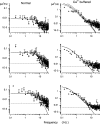The limit of photoreceptor sensitivity: molecular mechanisms of dark noise in retinal cones
- PMID: 15928405
- PMCID: PMC2234084
- DOI: 10.1085/jgp.200509277
The limit of photoreceptor sensitivity: molecular mechanisms of dark noise in retinal cones
Erratum in
- J Gen Physiol. 2006 Feb;127(2):219-20
Abstract
Detection threshold in cone photoreceptors requires the simultaneous absorption of several photons because single photon photocurrent is small in amplitude and does not exceed intrinsic fluctuations in the outer segment dark current (dark noise). To understand the mechanisms that limit light sensitivity, we characterized the molecular origin of dark noise in intact, isolated bass single cones. Dark noise is caused by continuous fluctuations in the cytoplasmic concentrations of both cGMP and Ca(2+) that arise from the activity in darkness of both guanylate cyclase (GC), the enzyme that synthesizes cGMP, and phosphodiesterase (PDE), the enzyme that hydrolyzes it. In cones loaded with high concentration Ca(2+) buffering agents, we demonstrate that variation in cGMP levels arise from fluctuations in the mean PDE enzymatic activity. The rates of PDE activation and inactivation determine the quantitative characteristics of the dark noise power density spectrum. We developed a mathematical model based on the dynamics of PDE activity that accurately predicts this power spectrum. Analysis of the experimental data with the theoretical model allows us to determine the rates of PDE activation and deactivation in the intact photoreceptor. In fish cones, the mean lifetime of active PDE at room temperature is approximately 55 ms. In nonmammalian rods, in contrast, active PDE lifetime is approximately 555 ms. This remarkable difference helps explain why cones are noisier than rods and why cone photocurrents are smaller in peak amplitude and faster in time course than those in rods. Both these features make cones less light sensitive than rods.
Figures







Similar articles
-
Tuning outer segment Ca2+ homeostasis to phototransduction in rods and cones.Adv Exp Med Biol. 2002;514:179-203. doi: 10.1007/978-1-4615-0121-3_11. Adv Exp Med Biol. 2002. PMID: 12596922 Review.
-
Activation and quenching of the phototransduction cascade in retinal cones as inferred from electrophysiology and mathematical modeling.Mol Vis. 2015 Mar 7;21:244-63. eCollection 2015. Mol Vis. 2015. PMID: 25866462 Free PMC article.
-
In retinal cones, membrane depolarization in darkness activates the cGMP-dependent conductance. A model of Ca homeostasis and the regulation of guanylate cyclase.J Gen Physiol. 1993 Jun;101(6):933-60. doi: 10.1085/jgp.101.6.933. J Gen Physiol. 1993. PMID: 8101210 Free PMC article.
-
Differences in calcium homeostasis between retinal rod and cone photoreceptors revealed by the effects of voltage on the cGMP-gated conductance in intact cells.J Gen Physiol. 1994 Nov;104(5):909-40. doi: 10.1085/jgp.104.5.909. J Gen Physiol. 1994. PMID: 7876828 Free PMC article.
-
Speed, sensitivity, and stability of the light response in rod and cone photoreceptors: facts and models.Prog Retin Eye Res. 2012 Sep;31(5):442-66. doi: 10.1016/j.preteyeres.2012.05.002. Epub 2012 May 29. Prog Retin Eye Res. 2012. PMID: 22658984 Free PMC article. Review.
Cited by
-
Detection of single photons by toad and mouse rods.Proc Natl Acad Sci U S A. 2013 Nov 26;110(48):19378-83. doi: 10.1073/pnas.1314030110. Epub 2013 Nov 8. Proc Natl Acad Sci U S A. 2013. PMID: 24214653 Free PMC article.
-
Transgenic mice carrying the H258N mutation in the gene encoding the beta-subunit of phosphodiesterase-6 (PDE6B) provide a model for human congenital stationary night blindness.Hum Mutat. 2007 Mar;28(3):243-54. doi: 10.1002/humu.20425. Hum Mutat. 2007. PMID: 17044014 Free PMC article.
-
The glutamic acid-rich protein-2 (GARP2) is a high affinity rod photoreceptor phosphodiesterase (PDE6)-binding protein that modulates its catalytic properties.J Biol Chem. 2006 Mar 3;281(9):5500-5. doi: 10.1074/jbc.M507488200. Epub 2006 Jan 3. J Biol Chem. 2006. PMID: 16407240 Free PMC article.
-
Multi-scale, numerical modeling of spatio-temporal signaling in cone phototransduction.PLoS One. 2019 Jul 25;14(7):e0219848. doi: 10.1371/journal.pone.0219848. eCollection 2019. PLoS One. 2019. PMID: 31344066 Free PMC article.
-
Functional significance of the taper of vertebrate cone photoreceptors.J Gen Physiol. 2012 Feb;139(2):159-87. doi: 10.1085/jgp.201110692. Epub 2012 Jan 16. J Gen Physiol. 2012. PMID: 22250013 Free PMC article.
References
-
- Beavo, J.A. 1995. Cyclic nucleotide phosphodiesterases: functional implications of multiple isoforms. Physiol. Rev. 75:725–748. - PubMed
Publication types
MeSH terms
Substances
Grants and funding
LinkOut - more resources
Full Text Sources
Miscellaneous

